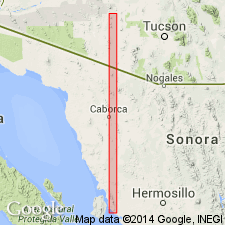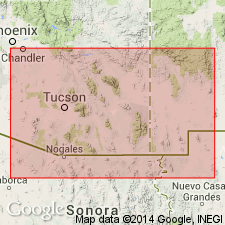
- Usage in publication:
-
- Chiapuk Rhyolite*
- Modifications:
-
- Original reference
- Dominant lithology:
-
- Rhyolite
- Tuff
- AAPG geologic province:
-
- Basin-and-Range province
Summary:
Pg. G1-G9. Chiapuk Rhyolite. Includes welded tuff and tuff-conglomerate, which are probably textural variants of same ash flow. Tuff is dense to porous, creamy to grayish-pink rock whose groundmass contains many angular fragments of dense pink porphyritic rhyolite and a gray, porous pumice. Fragments as much as 8 inches long. Groundmass generally cryptocrystalline and shows flow banding suggestive of plastic flow, particularly around pink rhyolite fragments; commonly groundmass contains small fragments of rhyolite and pumice and of broken feldspar crystals. Where basal contact is exposed, the welded tuff seems to lie conformably on Vekol Formation (new). Over a longer reach, the contact cuts obliquely across strike of Vekol, and the Chiapuk is probably separated from the Vekol by erosional surface of low relief. Top of unit either cut off by faults which abut the tuff against Escabrosa Limestone or is covered by alluvium. Truncated section about 200 feet thick. Is similar lithologically, stratigraphically, and structurally to Cat Mountain Rhyolite of Brown (GSA Bull., v. 50, 1939) in Tucson Mountains. Age is considered Late Cretaceous, based on similarity to Cat Mountain, which was dated at 70.3 +/-2.2 Ma and 74.1 +/-2.2 Ma by Damon (Arizona Univ. Geochron. Lab. Ann. Prog. Rpt., p. 8, 1963).
Type locality: about 2 mi west of Reward Mine, Vekol Mountains, Papago Indian Reservation, southwestern Pinal Co., southwestern AZ. Named from nearby village of Chiapuk.
Source: Publication; US geologic names lexicon (USGS Bull. 1350, p. 147).

- Usage in publication:
-
- Chiapuk Rhyolite*
- Modifications:
-
- Age modified
- AAPG geologic province:
-
- Basin-and-Range province
Summary:
Is youngest Cretaceous formation in Vekol Mountains (Pinal Co, AZ) in Basin-and-Range province. Overlies Vekol Formation (Campanian). Is considered possible, if not probable, that both Vekol and Chiapuk are general equivalents to Salero Formation in Santa Rita Mountains. Age is shown to be Campanian and Maestrichtian (Late Cretaceous) on correlation chart (fig. 5); redefined from late? Mesozoic.
Source: GNU records (USGS DDS-6; Denver GNULEX).
For more information, please contact Nancy Stamm, Geologic Names Committee Secretary.
Asterisk (*) indicates published by U.S. Geological Survey authors.
"No current usage" (†) implies that a name has been abandoned or has fallen into disuse. Former usage and, if known, replacement name given in parentheses ( ).
Slash (/) indicates name conflicts with nomenclatural guidelines (CSN, 1933; ACSN, 1961, 1970; NACSN, 1983, 2005, 2021). May be explained within brackets ([ ]).

